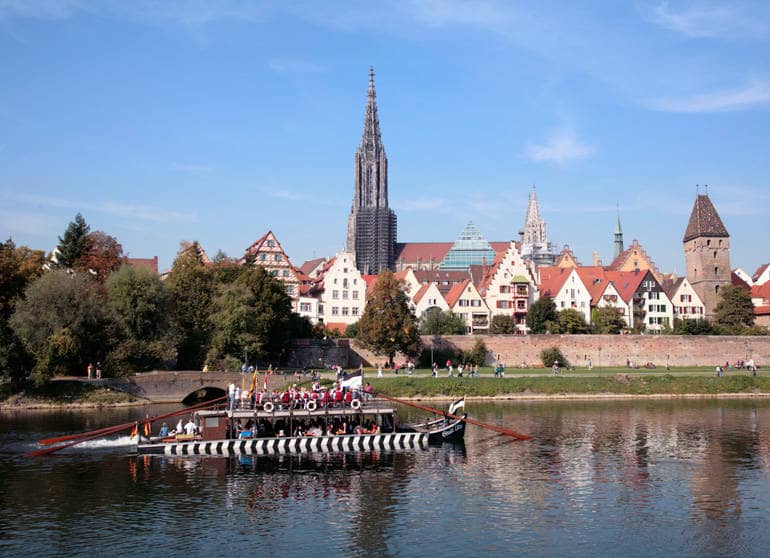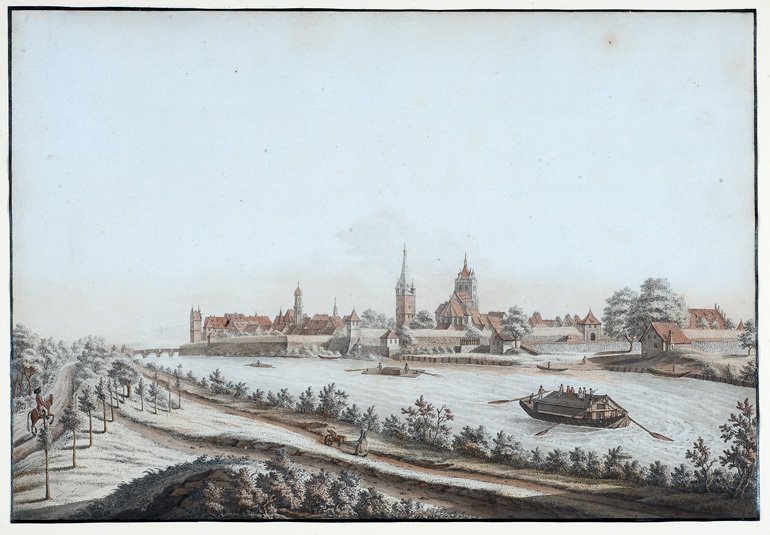The Ulmer Schachtel

© Stadt Ulm

© Stadt Ulm
Ulmer Schachtel vor dem Parlamentsgebäude in Budapest
The Danube takes on a new quality at Ulm thanks to the inflow of the Iller and Blau rivers: it becomes navigable. Because of this, it is one of the important trading routes that intersected early on in Ulm. Despite its drawbacks, it was always easier to negotiate than the roads, which were unsafe for a variety of reasons. The market regulations of the Austrian Danube city of Enns reveal that this occurred at a very early stage, recording the presence of Ulm merchants in the year 1164. This privilege was renewed in 1191, giving an idea of what was transported on the Danube at that time: Cloth from Europe’s north-west, skins, pelts and wax from Russia. Chronicler Felix Fabri also mentioned the waterways in 1488:
"Ulm gets timber from the Iller, various goods from
the Danube, but especially iron from further upstream,
and in turn sends its own wares on to other peoples using
the Danube itself.”
This was still done by raft at that time. Ships from Bavaria did also sail upstream to Ulm, but the people of Ulm had no ships of their own at that point.
This changed in the 16th century because of a timbershortage, which caused people, including those in Ulm, to seek an economical alternative to rafts. Wine Traders from the fishermen’s guild brought “Schopper” – theDanube ship builders – from Ingolstadt, Deggendorf and Windorf in what is now the district of Passau, to Ulm where, in 1570, they built the first large transport barges. The vessels they built were 26 metres long and 4 metres wide. The ship building yards (Schopperplätze) were situated on what is now the Neu-Ulm side of the river. a sign there gives the distance to the mouth of the Danube on the Black Sea: 2,586 kilometres. In Ulm these vessels were called “Zillen” (barges); the largest examples were known as “Wiener Zillen” in a nod to their destination of Vienna. The name changed further downstream though, and one of the last Ulm ship masters wrote:
“The Austrian customs tariff table, which classifies all types
of vessel according to their origin, calls the Ulm ships
“Schwabenplätte” (Swabian barges), and under this name
they are known everywhere as ships built only from fir
wood and used only for downstream journeys, and retain
this name in deepest Hungary, on the Tisza, Mures and
on the Hungarian canals.”
As is well known, the modern name for the “Wiener Zillen” is the “Ulmer Schachteln”. However, this originated as a pejorative term, which was used in the Stuttgart stateparliament to denigrate the Ulm shipping industry. Because of this, Ulm’s bargemen and their successors were unhappy with the term “Ulmer Schachtel” just a few decades ago.

© Stadt Ulm
The most widespread term though was “Ordinari-Schiff”, which referred to the schedule: these barges departed ordinarily, i.e. regularly, for Vienna on a set day of the week and using precisely defined tariffs. The journey lasted 8 to 14 days depending on the water level. This “Ordinari Wiener Schiff” had a good reputation. A traveller from1769 explains why:
1.) As the ship tied up each evening, I was able to sleep
leisurely at night, which would not have been possible
on the mail coach.
2.) The risk was not great, as the Ulm bargemen are so
cautious that when they anticipate a risk they continue
on to the next landing or stop for whole days rather
than exposing themselves to some misfortune; as I have
experienced several times.
This tourist describes the design of the passenger barges as follows:
A small structure stands at the centre of the Ordinari-
Schiffe, which is thrown together from planks and covered
with planks. This small structure usually consists of two
rooms. The room at the front is used by travellers of some
distinction. In winter there is normally a small stove, which
is heated from outside. There is a small window on each
side of the room, so that the people can see out. Planks
are used all around the room to make seating. You find
the baggage of the persons who are travelling in the room
under these benches. If there is any space left, the bargemen
also store other packages here that cannot be exposed
to the rain or snow. The bargemen also use these benches
as a dining table during the day, where they eat what they
have cooked on the small stove, and as a place to sleep
at night. The common folk are housed in the back room.
It has neither stove nor window, nor many benches
though; but most of those within sit or lie about on the
boxes and packages that the bargemen have put inside.
In addition to the “Ordinari-Schiffe”, there were also “Extra-Schiffe”, which were either used purely for cargo or as private ships rented by the wealthy. At the end of the 18th century this cost 100 to 200 guilders – 100 times the normal tariff.You would normally find around 40 people on board, though sometimes more, as on the emigration ships, for example, which travelled to Hungary carrying 100 to 150 people. The first known large wave of migration began in 1712 from Ulm down the Danube to Hungary, which had been liberated from the Turks. In 1786 around 3,000 emigrants boarded the ships in Ulm in the space of three months. Troop transports on the Danube must also be mentioned. Ulm’s bargemen first took a contingent of Swabian troops aboard their ships and rafts in 1667. These soldiers were bound for Hungary to fight against the Turks, as were those who followed, embarking in Ulm in 1683 and 1684. The troop transport by water organised by the Duke of Württemberg in 1758 is also worthy of mention: it comprised 6,000 men, 150 horses, 226 wagons on 57 ships and 70 rafts. The fleet of 34 ships built by the Ulm boat builders in just three weeks in 1745 was more peaceful though: this was used to transport the imperial couple Franz I and Maria Theresia and their entourage safely back to Vienna following the coronation in Frankfurt.

© Stadt Ulm
Ulm von Osten, J.P. Fehr, 1795
That was exceptional though. The boats were normally used to move goods, the European dimension of which was described by German traveller Friedrich Nicolai in 1781:
The Danube is used predominantly for goods destined
for Bavaria and Austria, which are brought to Ulm by
waggoners from France via Strasbourg, from Italy via
Augsburg and for other onward transport. The house of
Kindervatter had the largest shipping company for goods
and monies, which came to Vienna from the Netherlands
on behalf of the Kaiser.
The cargo altered in line with changing needs. In 1571, for example, the Danube toll collector von Straubing recorded an annual income of 22,000 pails of wine, which came almost exclusively from Ulm. Other Containers held Ulm snails. Early popular cargoes included Ulm linen, goods made by the city’s woollen weavers, pear slices, dried fruit, beets, Neckar wine, Ulm playing cards and wafers. In the 19th century it was French wines, saplings, leather, dyes, flintstones, grass and clover seeds, wooden clocks and other “goods from Western Europe”, which found their way in this manner to Austria, Hungary, Poland, Russia and Turkey. At the end, the main cargo consisted of asphalt for roadbuilding in the large Danube cities. This was supplemented by ploughs made by the Eberhardt brothers, as well as cartgrease, salted intestines and furniture springs. The destinations at that time, sorted according to the weight of the cargo to be delivered there: Budapest, Vienna, Passau, Regensburg, Straubing, Linz, Vilshofen, Ingolstadt, Neustadtand Deggendorf. In contrast, upstream shipping along the Danube was never very significant. Ultimately, the barges that came from Bavaria to Ulm – and were known, therefore, as “Bayerschiffe”or “Hohenauer” – had to be pulled by ten to twelve horses. Around 1825 they brought Hungarian copper, tobaccoleaves, wine, yarn from Linz, horsehair from Bavaria, pigbristles from Poland and Russia, Bohemian mushrooms, mercury and crucibles from Passau.
Ultimately, the shipping on the Danube could not withstand the competition from the railways. Attempts to extend the route of the Danube steamboats to Ulm also ran aground in a sense. Finally in 1897, the last Commercial “Wiener Zille” was decommissioned in Ulm.This vessel has by no means been forgotten, however. It had already become a symbol of Ulm – the characteristic black and white stripes on the ship’s side certainly having played a part in that. Indeed, they had already been interpreted as Ulm’s city colours of black and white in the 19th century. It was only in Ulm that barges on the Danube had been decorated with stripes of black tar dye, which contrasted with the natural white of the firwood – this distinctive design was probably intended to increase visibility and, thus, improve safety.

© Stadt Ulm
Ulmer Schachtel vor dem Bundestag in Berlin
A new type of Ulm Danube travel, an early form of tourism, began just ten years after the end of Commercial shipping on the river. Groups of tourists procured discarded barges and travelled on them to Vienna under the expert guidance of the Ulm bargemen. During this period, the design of the Schachtelboats, which had originally involved a hut-like structure, changed to the now familiar flat roof, which actually does look rather box-like. However, the maker of this new type of barge did not come from Ulm at all, but was a Berlin professor named Eduard Hahn, who travelled from Ulm to Vienna on such a ship for research purposes in 1907. The Ulm Tourism Association adopted this form when it organised a Schachtel voyage for the first time in 1914, the aim, alongside the pleasure of travel, being to maintain traditions and contact along the Danube. These planned Schachtel voyages resulted in a somewhat improved design in terms of comfort on-board. The one-way vessel, which used to be broken up at ist destination for firewood by barge wreckers (Plättenschinder), became a multi-route ship, which since 1925 has been returned to Ulm first by rail and nowadays by low loader. Since 1926 the Ulmer Schachteln have also been powered by motors, and the journey would be impossible without them now. Numerous barrages were installed on the Upper Danube during the 20th century, which slow the speed of the river, and each has to be crossed via a lock. The power that is drawn from the river has, therefore, to be fed back to the ship.The design and build method of the Ulmer Schachtel has changed dramatically as a result – but not its symbolism: it not only represents nostalgia, but also no less the cosmopolitan outlook that the people of Ulm claim for themselves and for good historical reason.

